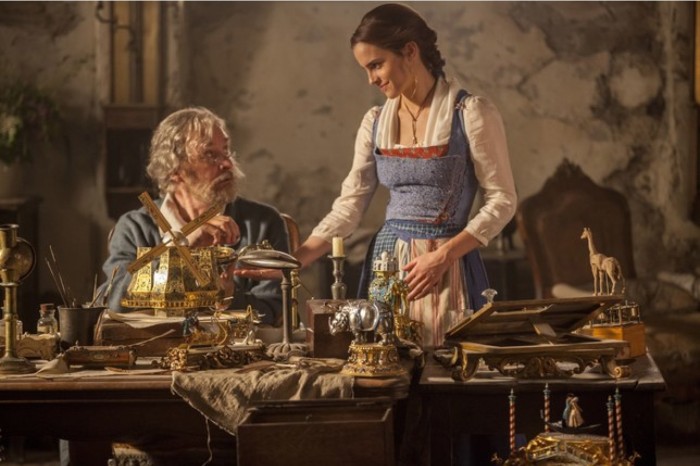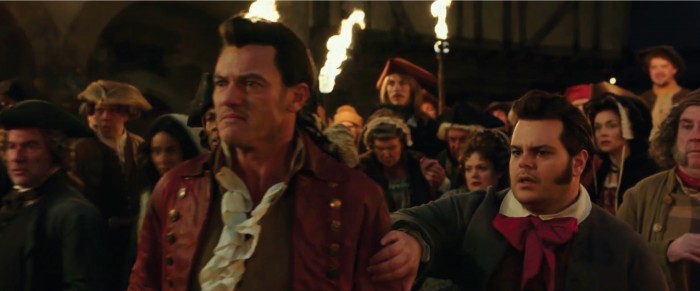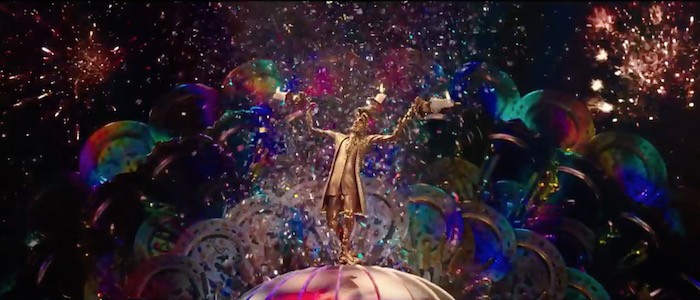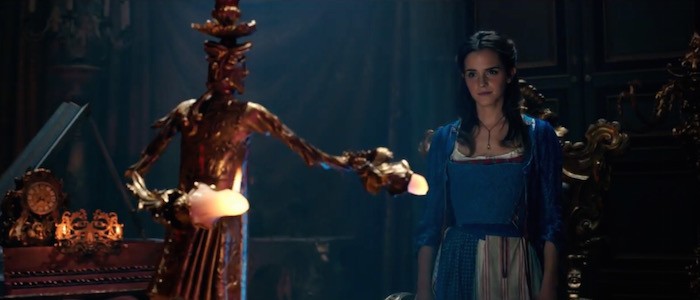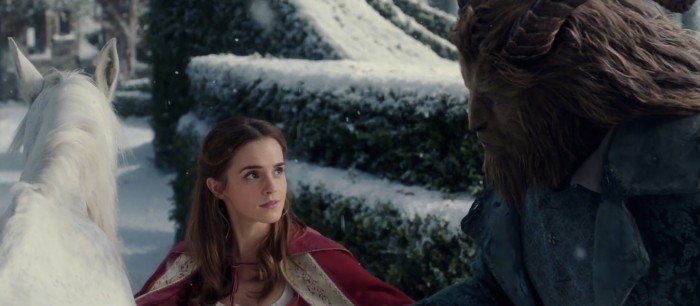How The New 'Beauty And The Beast' Compares To The Animated Classic
(In our Spoiler Reviews, we take a deep dive into a new release and get to the heart of what makes it tick...and every story point is up for discussion. In this entry: Bill Condon's Beauty and the Beast.)
Once Walt Disney Pictures began adapting its animated classics for live-action, starting with Tim Burton's 2010 take on Alice in Wonderland and moving into villain-centered fairy tales like Maleficent, it was a safe bet that a new version of Beauty and the Beast wouldn't be too far behind. The 1991 film is beloved the world over and was a central part of pop culture for countless Millennials growing up. Plus, it garnered heaps of critical praise and a Best Picture nomination at the Oscars, the first for an animated film. So it's no surprise that Disney has gone all-in with its live-action remake of Beauty and the Beast: it boasts an all-star cast including Emma Watson, Dan Stevens, Ewan McGregor, Ian McKellen, Luke Evans, and more; its director, Bill Condon, has directed everything from entries in the Twilight Saga to the Dreamgirls musical adaptation; and its reported $160 million budget is evident in the sets, costumes, and extensive CGI.
But can the new Beauty and the Beast compare to the 1991 classic? Does this remake feel as timeless as the film that inspired its existence? Or do its changes — and there are quite a few — feel dull and lifeless? Let's dive in and compare the original and its remake to find out.
Change That Doesn’t Work: The Mystery of The Missing Mother
The new Beauty and the Beast answers a number of questions that the 1991 film either raises without answering or simply ignores. If the young Prince and his servants were cursed by an enchantress, whatever happened to the parents of this spoiled child? How exactly does the timeline work if a human was turned into a monstrous beast roughly 10 years before his 21st birthday? Wouldn't the people of the small village where Belle and Maurice live remember a period when there was a castle and royalty nearby? All of these questions, and more, are answered in the live-action film; at times, it seems more like a direct response to one of those Everything That's Wrong With Movie X viral videos than an actual romance.
Answering these questions is an obvious change, but that doesn't automatically mean it's an improvement. The animated classic has stood the test of time in part because not providing the answers to those questions allows for some mystery. We don't need to know, for example, that the villagers don't remember the castle or its denizens because the same enchantress who cursed the Prince to be a Beast also had the power to make them forget that Prince or his castle ever existed.
But of all the not-necessary-to-solve mysteries that get clarified in the live-action film, the most baffling and useless is that of Belle's mother. In the animated film, Belle's mother isn't mentioned; there's the inventor Maurice, his bookish daughter Belle, and that's it. In this movie, from the beginning, it's evident that we will learn the truth behind a Very Important Backstory: what happened to Belle's mother. Maurice, it turns out, has never revealed to Belle what happened to her mom, and is fearful of ever revealing the truth lest she try to...run away, perhaps. Or maybe just get really, really mad. Lucky for Maurice, he doesn't even have to worry about telling her the real story behind her mother's death.
During her initial time in the Beast's castle, Belle is introduced to what might as well be called a bonus spell that the enchantress left behind to taunt the victim of her curse: a magical book that allows its reader to transport himself or herself to any place (and at any period of time) in the world. Belle sends herself, and the Beast, to Paris. Specifically, she sends herself to the small flat where she lived as a baby with Maurice and her very sick mother. Yes, you see, in this version of Beauty and the Beast, Belle's mother died of the plague, which is why Maurice took her away into the countryside. (We know it's the plague because the Beast says it dryly after inspecting a doctor's mask that also looks like a prop from the orgy scene in Eyes Wide Shut.)
Leave aside, for an instant, the question of how, or why, it is that the enchantress put a spell on a magic book to allow its user to travel in space and time. Leave aside, for an instant, the fact that this magic book is not mentioned at any other point in the film, nor is it referenced elsewhere, making its existence necessary solely for this revelation and sequence. Focus only on the revelation: Belle's mother died when her child was barely out of the womb, and her father left the woman to die so their child could survive. It is indeed a noble sacrifice, and one that Belle appreciates instantly.
But it doesn't serve much of a purpose within the story. All it does is allow the Beast to realize that when he called Maurice a thief for taking a rose from his garden (by request of Belle), he might have been, oh, a little bit harsh. Belle does not change because of this new information; instead, it raises the obvious question of why Maurice refused to tell her this before. The idea that Belle's mother dying of the plague was some unspeakable secret is baffling especially because Belle is such a strong character, clearly able to handle even a devastating bit of news like this. Emma Watson—who acquits herself nicely as long as she's not singing here—plays Belle as even more forthright and strident than the character is in the animated film, not as a wilting flower. Thus, in a movie that ends up nearly 130 minutes long, a scene where Belle discovers the not-at-all-shocking truth of her mother's death feels like a waste of time.
Change That Works: Gaston and LeFou
Gaston, as voiced by Richard White in the 1991 animated film, is one of the all-time great Disney animated villains. He's an exaggerated version of the Prince Charming type from past Disney films: handsome and rugged, but also forceful and driven to insanity by his inability to get the girl of his dreams, the fiercely disinterested Belle. Though his trusty associate LeFou tries to buck up Gaston's spirits, only attempting to satisfy his bloodlust by killing the Beast, an unexpected romantic rival, can roust the vain hunter. In many respects, the Gaston of the live-action film is not terribly different: he's treated as the most handsome man in town, fawned after by many young women; he's always joined by his sycophantic friend LeFou; and his inability to lure Belle drives him to madness as he tries to destroy her true love.
Though Luke Evans doesn't have the same booming baritone that White does, his take on Gaston is surprisingly more nuanced. At his core, Gaston is still a self-centered braggart—in an early moment, we see him bestowing an extremely high compliment on his mirror image. But from his first scene, it's clear that the screenplay, by Stephen Chbosky and Evan Spiliotopoulos, is going to slightly veer from the original film. Where the animated Gaston is introduced by shooting a bird out of the sky, here, we only see Gaston and LeFou returning to the small village they call home, reminiscing about their time in the war. In fact, it takes a much longer time in this Beauty and the Beast for Gaston to embrace his inner bad guy.
The animated version of the song that bears his name, for example, culminates in Belle's lovable, but kooky, father Maurice begging for help and being thrown out on his ear; in the live-action version, when Maurice warns tavern-dwellers of a hideous beast that's taken his daughter captive, Gaston willingly goes with the old man to see if his wild tale is true. And when Gaston fears he's been led on a wild-goose chase, he's temporarily placated by LeFou to try and put on a presentable face, if only to curry a blessing from Maurice. Evans, much more so than in some past roles, has a lot of fun with an antagonist fighting an internal battle between trying to "woo and marry Belle" and turning into a Neanderthal.
Much, of course, has been made of how LeFou has changed in this new Beauty and the Beast, with director Condon recently saying the character is not only gay, but has an "exclusively gay" moment in the film. That may be true, but said moment—in which LeFou dances with a man—takes up less time than it took for you to read this sentence. If anything, Disney shouldn't be too proud of the fact that one of their first out gay characters has a name that, in English, translates to "the fool" and harbors a crush on someone who treats him cruelly.
Having said that, Josh Gad, only a couple years removed from voicing the summer-loving snowman Olaf in Frozen, represents a welcome bit of levity as the new LeFou. (His exhortation to get Gaston to calm down: "Think of the war!") LeFou is, at heart, smarter than Gaston, realizing how dangerous his friend is becoming even if he's enabled the larger man because of a misbegotten crush. The live-action Gaston and LeFou may not be better than the animated version of the villain and his hapless henchman, but in a film that's otherwise struggling to come to life, Evans and Gad do so every time they step on screen. They, at least, seem to know what kind of movie they're in and how best to imbue their scenes with spirit.
Change That Doesn’t Work: The Servants’ New Faces
The live-action Beauty and the Beast is, of course, heavily laden with CGI effects, specifically in depicting the anthropomorphized household objects that were once the Beast's servants. Characters like Lumiere, Cogsworth, Mrs. Potts, and more have been brought to life through computer technology that wasn't even possible back in 1991, when the characters were all hand-drawn. What's genuinely fascinating is that so much of this new movie, from the costume design for Gaston or Belle all the way to some shots being mirrored, is a direct copy of the animated film. Yet one area that is radically different is in the look of Lumiere and friends. It's not as if computer animation couldn't replicate how these characters looked in the original film; think of a film like Frozen, which may be computer-animated but attempts to mimic the hand-drawn animated style for its story. But for whatever reason, the household objects in this film are meant to look much more like...actual household objects than they do in the animated film.
That attempt at photo-realism simply doesn't work. One of the many wonderful aspects of the characters in the 1991 film is that you could see their expressive, vibrant, truly animated faces. What's more, they were brought to life in a way that somehow sidesteps the fact that the premise of this story is exceedingly horrifying: a group of innocent people have been trapped inside of household objects! They're possibly doomed to an eternity of functioning as candelabras, clocks, teapots, and more than as humans! In the animated film, this fate isn't totally ignored; it simply doesn't seem as creepy because Lumiere, Cogsworth, and the rest have lively faces. They almost feel more human as objects than they do when they turn back into their original form.
In the new movie, it's hard to argue that the household-object versions of the servants seem remotely human, or even lifelike. Mostly, these characters' faces and eyes have been transformed so that they're part and parcel of the objects they inhabit. Thus, the Ian McKellen-voiced Cogsworth has "eyes," but they're just two circular parts of his clockwork. The new Lumiere has a mouth, designed as a gaudy flourish in the workings of his candelabra. Mrs. Potts' eyes and mouth are barely drawn on, meant as additions to the design of her "body." Some characters, such as Lumiere's love interest Plumette (a feather duster) or Madame de Garderobe, don't really have faces or eyes or mouths; when Gugu Mbatha-Raw, who plays Plumette, utters dialogue, it's not so much emanating from the CGI feather duster as it is an off-screen line reader. Whatever soul these characters had in the animated film is largely lost because the CGI versions are, ironically enough, lifeless.
Change That Works: The Castle—It’s Alive!
In the 1991 film, it's suggested that the Beast and his servants aren't the only things that transformed due to the enchantress's spell. The whole castle has fallen under this dark magic, growing grim and forbidding to the outside world. When the spell is lifted at the end, the castle, its gargoyle-esque parapets, and even the gloomy weather surrounding the area turns into a bright, inviting, and stately mansion. The same is true in the live-action film, but it's literalized more directly, in a novel fashion. When each petal of the enchanted rose falls, housed in a fancy glass jar, it's not just that the Beast knows his time is running out: it's that the castle falls into further disrepair, and that the servants grow further away from their human states.
This is one of the more subtle expansions within the story, and arguably one of the strongest. In this version of the story, the curse that the enchantress places on the young, vain Prince impacts the entire town, not just him and his servants. (An unnecessary aspect of this is that the enchantress is present throughout the film, hidden in plain sight as a common beggar woman, as opposed to the comically unpleasant-looking hag in the prologue.) As much as the CGI versions of the servants-turned-household-objects may be visually unappealing, when another rose petal falls and their bodies essentially move one closer to being fully inanimate, it's striking. In these moments, Condon creates the right type of palpable, body-horror-esque dread the characters feel towards their shared predicament.
The castle falls apart, brick by brick, as the story progresses, but it all comes literally crumbling down in the climax. Its disrepair mirrors that of the Beast's psyche, but the way each pillar, staircase, and trellis breaks apart as the Beast and Gaston have their gruesome showdown goes further than the animated film does. When Gaston shoots the Beast, leaving him at death's door, he seals his own fate: the last rose petal falls concurrently, and the walkway on which he's standing crumbles, leading him to his death. In this sense, it's not just that the servants bring household objects to life. The castle itself is almost a living, breathing entity, as trapped as the Beast himself is. In a film that otherwise spells out many of its major themes, the castle's livelihood and its crumbling façade is a fascinating, mostly unspoken, and very welcome grace note.
Change That Doesn’t Work: The Beast’s Lack of Kindness
The Beast, when Belle first meets him both in the animated and live-action versions of this story, is callous and cruel: he's imprisoned a helpless old man for meaningless offenses and isn't much bothered when she tries to take his place. However, the Beast's lack of kindness extends a bit more in the live-action film in ways that don't seem necessary, turning the character even colder than before.
To wit: in the animated film, Belle switches places with Maurice and is heartbroken when she isn't able to say goodbye to her father, but is at least given her own room by the Beast after he relents a bit due to the guilt he feels. In the live-action film, Maurice refuses to let his daughter switch places with him; Belle is able to get the Beast to give her a minute alone to say goodbye, during which she tricks her old man into exiting his cell and letting her step in. Afterwards, she does get her own suite...because Lumiere (voiced by Ewan McGregor, whose Maurice Chevalier-esque French accent needs a lot of work) frees her and brings her to the room himself. When the Beast eventually finds out, he's furious.
Here's another example: in the animated film, as Belle and the Beast grow closer to each other, the Beast actively decides to give her a gift. The gift comes in the form of his gigantic library, with rows upon rows upon rows of books, far more than she may have read in the village where she lives. Belle, ever the bookworm, is of course dazzled and thrilled. In this version, the Beast does show off his library to a duly impressed Belle, but he does so without intending to present it as a gift. He basically walks her into the library, after having surprised her with his knowledge of (and mansplain-y distaste for) the works of William Shakespeare. Once the Beast realizes how much of an impact this library has on Belle—whose local library is, in the live-action version, a group of ten or so volumes that she's likely read many times—he lets her take whatever she wants.
Both of these decisions are minor changes, but they speak to the unresolved callousness that the Beast displays in this version. The live-action Beauty and the Beast is 45 minutes longer than the animated film, which would seem to allow the screenwriters more time to develop the romantic relationship between the leads. (Belle, headstrong in the animated film, is a bit fiercer here and more direct at first regarding her antipathy towards her captor.) Instead, with changes like this, the Beast seems colder in ways that don't allow for Belle to gradually fall in love with him. Dan Stevens is well-cast as the Beast, and does a solid job of transforming from a shallow, dismissive jerk into a kind and gentle hero, though he kind of sells the shallowness a bit too well.
In some sense, it tracks with how we first meet the Prince: the new version of the prologue eschews the stained-glass artistry from the animated film, instead depicting him as a be-wigged fop at the center of an excessively gaudy ball whose disdain towards the enchantress in her haggardly form seems natural. Thus, when the Beast shows off his library as if it's no big thing, it's a leftover bit of the same shrugging condescension that got him in trouble in the first place. That's all well and good, but in the animated film, the Beast gifting his library to Belle is a sign that, monster or not, he's actively trying to be a kinder and more thoughtful soul. Here, by not showing off the library or allowing Belle her own, non-prison-cell-like space, the Beast is simply kind of a dick when he's supposed to be shining through.
Those changes represent the new Beauty and the Beast in a microcosm. Many of the elements of the original animated film have been ported over to this new, fancier, gaudier-looking version of the story, but they've been tweaked just enough to try to be different. But as much as Bill Condon and Disney may have wanted to turn this story into something new, it is still a tale as old as time. And it's a tale that has largely been told better before.

